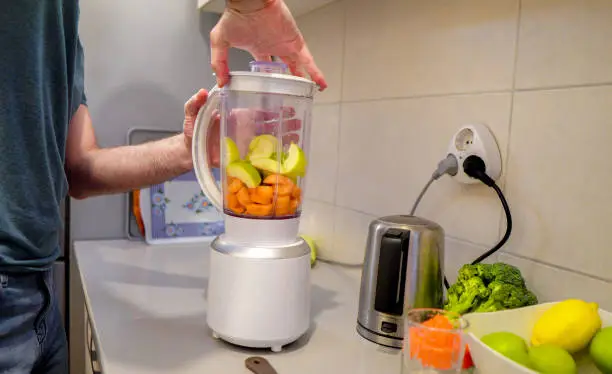Blending fruits and vegetables into nutritious juices and smoothies has become an increasingly popular way for Indians to get more nutrients into their daily diet. When considering buying a blender for home use or opting for a portable juice blender, there are some key factors regarding practicality and blending performance.
Criteria for Selecting a Home Nutri Blender
When looking to buy a Nutri blender for home and family use, some ideal features to look for include:
Power and Blending Abilities
– A 700-900 watts or higher motor provides good blending power for most ingredients. This ensures smooth purées and crushed ice drinks.
– Multiple speed settings allow better control when preparing various consistencies from smoothies to nut butters.
– Specialized functions like a smoothie program or pulse feature help blend thicker mixtures.
Container Capacity
– A blender pitcher of around 1.5 to 2 liters suits most small or medium-sized families.
– Larger capacity containers available on some models are good for larger families or batch meal prepping.
Easy Use and Cleaning
– Intuitive controls should allow easy operation even for beginners.
– BPA-free plastic containers are durable and simple to clean after use.
– Dishwasher-safe parts cut down on post-blending cleanup time.
Additional Aspects for Portable Juice Blenders
Portable juice blenders offer different advantages from countertop models that are also useful to consider:
Easy Transport
– Compact size and integrated cups allow filling with ingredients and blending directly while on the go. No need to transfer juices or smoothies after blending.
– Most portable blenders are powered either via rechargeable lithium batteries or the capability to plug into car charging outlets for operation almost anywhere.
Quick Cleaning
– Blending directly into drinking cups means fewer parts to take apart and clean later.
– Travel lids usually seal well to avoid spills while transporting freshly blended drinks.
Limitations on Capabilities
– Lower power motors in battery-powered models translate to longer blending times for some combinations like leafy greens or ice. May occasionally need some added liquid to get ingredients moving.
– Smaller capacity cups with portable blenders limit batch sizes but work well for making personal portions.
Tips for Selecting the Best Portable Juice Blender Model
Focusing on a few key performance factors helps narrow down the selection when looking to buy the best portable juicer blender for individual needs:
Blending Power
– Wattage ranging from 200 to 300 is typical for battery-powered portable models, which provide adequate blending ability for most uses.
– Some options can be plugged into wall outlets for a power boost when blending thicker mixtures is desired.
Cup Capacity
– Standard cups are 300 to 500 ml for on-the-go drinking directly from the blending container.
– Models with multiple cup sizes or wide-mouth openings allow adding whole fruits/veg easily.
Battery Life
– Rechargeable lithium batteries that run from 20 to 40 minutes maximize portable blending capacity between charges.
Popular Nutri Blender Brands in India
When evaluating different nutri blender models for Indian homes, several reputable appliance brands consistently offer high-performing and durable options:
– Philips blenders are popular for their power, specialized blending programs, and easy cleaning functions. The Philips Daily Collection HR7629 model with 800W motor and 1.5L pitcher is a good value home blender.
– Bajaj specializes in affordable but reliable mixers and blenders for the Indian market. The Bajaj GX-1 500W blender provides very good blending abilities for budget-conscious buyers.
– Panasonic blenders like the MX-SS1 model utilize Japanese technology for efficient, quiet blending performance. This brand is known for quality and after-sales support.
– Prestige offers a wide range of mixers, juicers, and blenders with the reliability expected from this household brand name. The Prestige Iris 750W blender packs robust blending into a compact design.
Which Is More Practical: Countertop or Portable Models?
When deciding between a traditional home blender and a portable blending device, consider daily habits and nutrition goals. Countertop Nutri blenders allow easy daily whipping up of single servings or batches of smoothies, juices, soups, and more. Their higher power means effortless blending even with frozen items or tough ingredients like seeds or ice. A countertop blender is likely the better practical choice for frequent use or preparing blender drinks for the whole family.
However, portable blenders uniquely blend fresh juices, protein shakes, and smoothies to take anywhere on the go. Portable blenders are extremely useful for Indian professionals, students, or commuters who want to save time and money on grabbing healthier drinks outside the home.
The convenience of blending and sipping drinks directly from the same portable container also makes cleaning up faster after use.
By clearly identifying blending needs and how often mobility is important, Indian consumers can pick the type of blender that best enhances their nutrition routines. Investing in a quality Nutri blender for the kitchen or a portable blending device delivers versatility for creating healthier homemade beverages customized to individual tastes.
Keep an eye for more news & updates on WebOfBuzz!




